battery YAMAHA YZF-R6 2013 Owners Manual
[x] Cancel search | Manufacturer: YAMAHA, Model Year: 2013, Model line: YZF-R6, Model: YAMAHA YZF-R6 2013Pages: 110, PDF Size: 2.43 MB
Page 7 of 110

TABLE OF CONTENTS
Checking the wheel bearings ....... 6-33
Battery .......................................... 6-33
Replacing the fuses ...................... 6-35
Replacing a headlight bulb ........... 6-36
Tail/brake light .............................. 6-37
Replacing a turn signal light bulb ........................................... 6-37
Replacing the license plate light
bulb ........................................... 6-38
Auxiliary light ................................ 6-39
Supporting the motorcycle ............ 6-39
Front wheel ................................... 6-40
Rear wheel ................................... 6-42
Troubleshooting ............................ 6-44
Troubleshooting charts ................. 6-45
MOTORCYCLE CARE AND
STORAGE .......................................... 7-1
Matte color caution ......................... 7-1
Care ................................................ 7-1
Storage ...........................................7-4
SPECIFICATIONS ............................. 8-1
CONSUMER INFORMATION ............. 9-1
Identification numbers .................... 9-1
U1JSE1E0.book Page 2 Wednesday, June 6, 2012 10:05 AM
Page 14 of 110
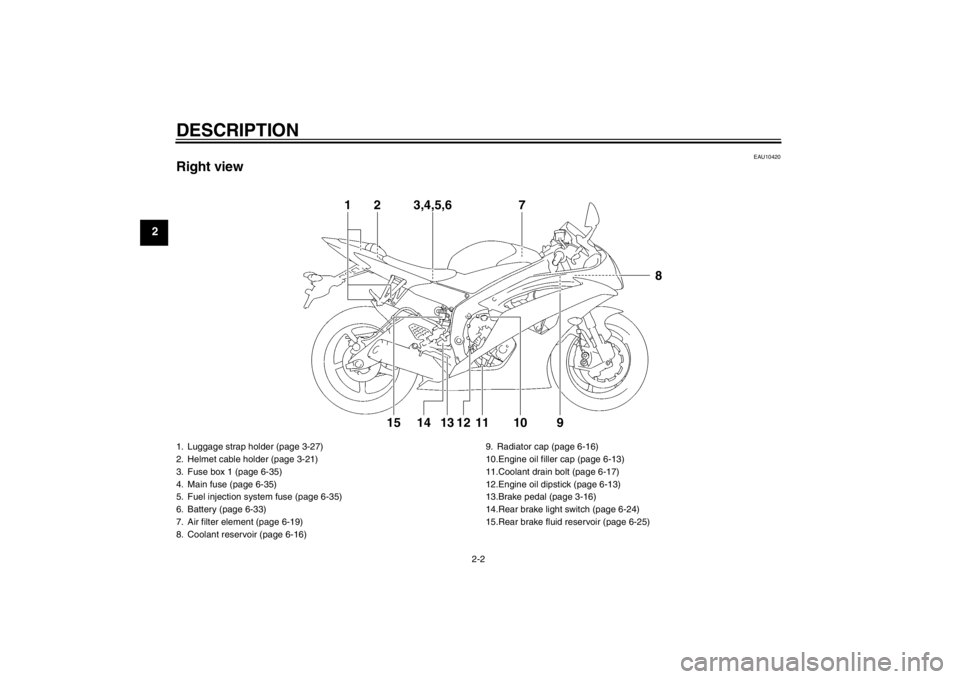
DESCRIPTION
2-2
2
EAU10420
Right view
1
2
3,4,5,6
710
9
8
11
12
13
14
15
1. Luggage strap holder (page 3-27)
2. Helmet cable holder (page 3-21)
3. Fuse box 1 (page 6-35)
4. Main fuse (page 6-35)
5. Fuel injection system fuse (page 6-35)
6. Battery (page 6-33)
7. Air filter element (page 6-19)
8. Coolant reservoir (page 6-16)9. Radiator cap (page 6-16)
10.Engine oil filler cap (page 6-13)
11.Coolant drain bolt (page 6-17)
12.Engine oil dipstick (page 6-13)
13.Brake pedal (page 3-16)
14.Rear brake light switch (page 6-24)
15.Rear brake fluid reservoir (page 6-25)U1JSE1E0.book Page 2 Wednesday, June 6, 2012 10:05 AM
Page 18 of 110
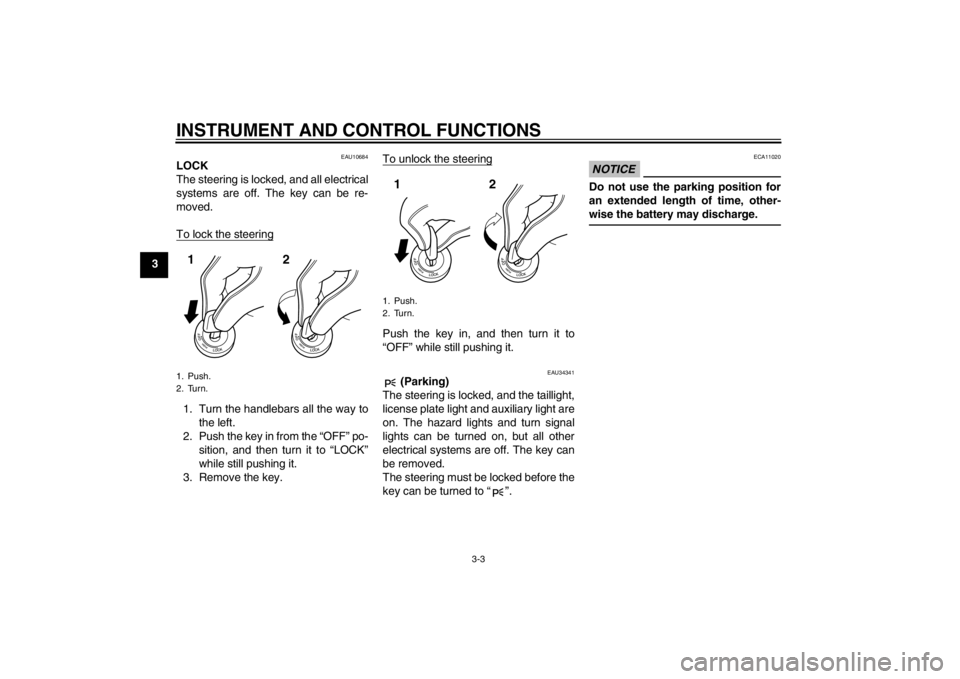
INSTRUMENT AND CONTROL FUNCTIONS
3-3
3
EAU10684
LOCK
The steering is locked, and all electrical
systems are off. The key can be re-
moved.
To lock the steering1. Turn the handlebars all the way tothe left.
2. Push the key in from the “OFF” po- sition, and then turn it to “LOCK”
while still pushing it.
3. Remove the key. To unlock the steering
Push the key in, and then turn it to
“OFF” while still pushing it.
EAU34341
(Parking)
The steering is locked, and the taillight,
license plate light and auxiliary light are
on. The hazard lights and turn signal
lights can be turned on, but all other
electrical systems are off. The key can
be removed.
The steering must be locked before the
key can be turned to “ ”.
NOTICE
ECA11020
Do not use the parking position for
an extended length of time, other-
wise the battery may discharge.
1. Push.
2. Turn.12
1. Push.
2. Turn.12
U1JSE1E0.book Page 3 Wednesday, June 6, 2012 10:05 AM
Page 84 of 110
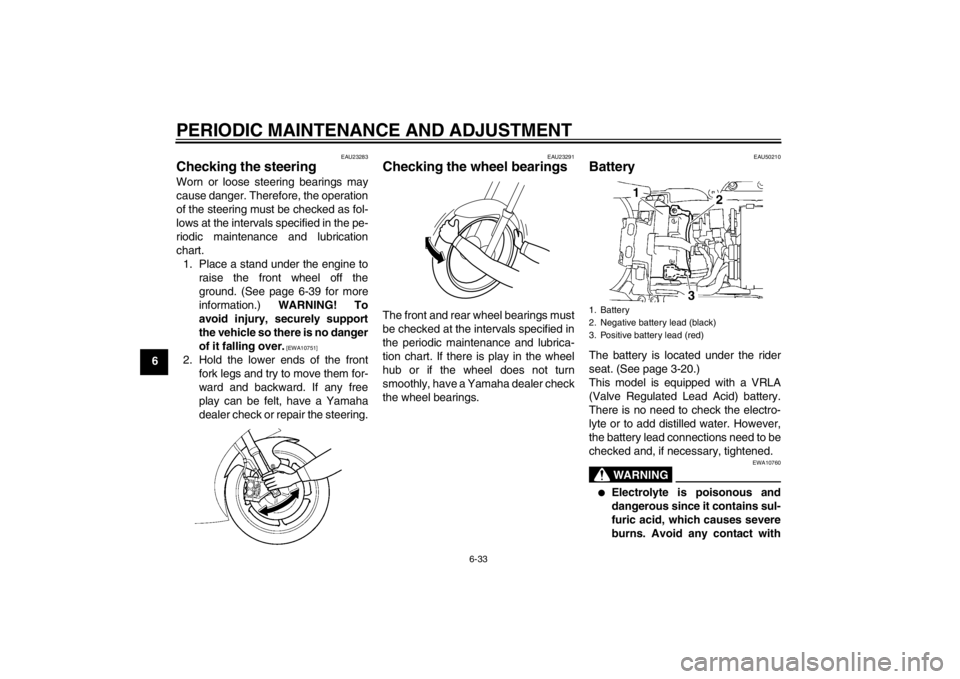
PERIODIC MAINTENANCE AND ADJUSTMENT
6-33
6
EAU23283
Checking the steering Worn or loose steering bearings may
cause danger. Therefore, the operation
of the steering must be checked as fol-
lows at the intervals specified in the pe-
riodic maintenance and lubrication
chart.1. Place a stand under the engine to raise the front wheel off the
ground. (See page 6-39 for more
information.) WARNING! To
avoid injury, securely support
the vehicle so there is no danger
of it falling over.
[EWA10751]
2. Hold the lower ends of the front fork legs and try to move them for-
ward and backward. If any free
play can be felt, have a Yamaha
dealer check or repair the steering.
EAU23291
Checking the wheel bearings The front and rear wheel bearings must
be checked at the intervals specified in
the periodic maintenance and lubrica-
tion chart. If there is play in the wheel
hub or if the wheel does not turn
smoothly, have a Yamaha dealer check
the wheel bearings.
EAU50210
Battery The battery is located under the rider
seat. (See page 3-20.)
This model is equipped with a VRLA
(Valve Regulated Lead Acid) battery.
There is no need to check the electro-
lyte or to add distilled water. However,
the battery lead connections need to be
checked and, if necessary, tightened.
WARNING
EWA10760
●
Electrolyte is poisonous and
dangerous since it contains sul-
furic acid, which causes severe
burns. Avoid any contact with
1. Battery
2. Negative battery lead (black)
3. Positive battery lead (red)
1
2
3
U1JSE1E0.book Page 33 Wednesday, June 6, 2012 10:05 AM
Page 85 of 110
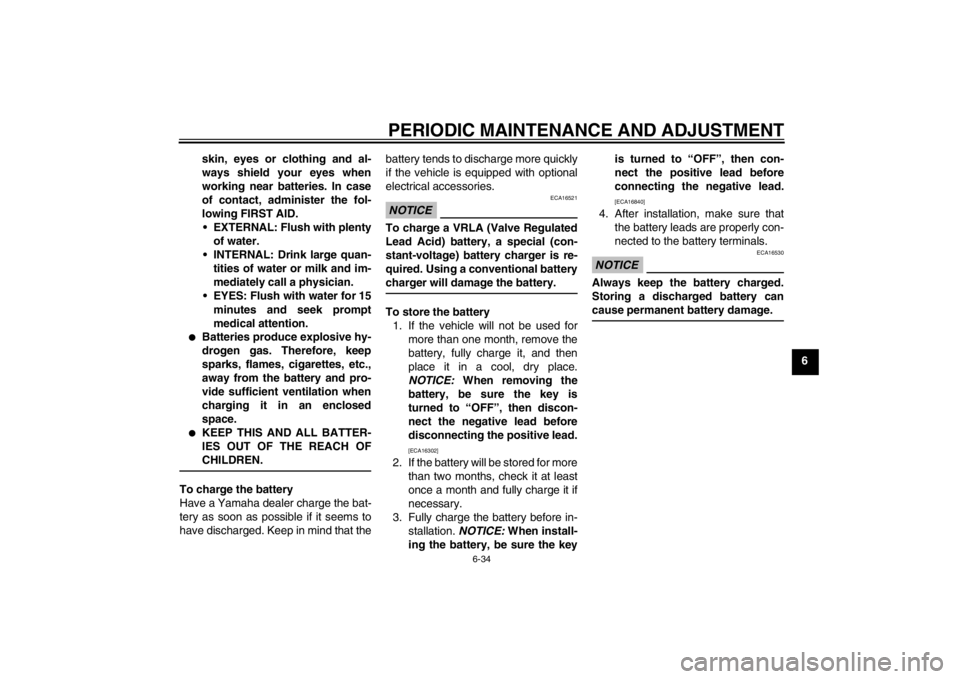
PERIODIC MAINTENANCE AND ADJUSTMENT
6-34
6
skin, eyes or clothing and al-
ways shield your eyes when
working near batteries. In case
of contact, administer the fol-
lowing FIRST AID.
EXTERNAL: Flush with plenty of water.
INTERNAL: Drink large quan- tities of water or milk and im-
mediately call a physician.
EYES: Flush with water for 15 minutes and seek prompt
medical attention.
●
Batteries produce explosive hy-
drogen gas. Therefore, keep
sparks, flames, cigarettes, etc.,
away from the battery and pro-
vide sufficient ventilation when
charging it in an enclosed
space.
●
KEEP THIS AND ALL BATTER-
IES OUT OF THE REACH OF
CHILDREN.
To charge the battery
Have a Yamaha dealer charge the bat-
tery as soon as possible if it seems to
have discharged. Keep in mind that the battery tends to discharge more quickly
if the vehicle is equipped with optional
electrical accessories.
NOTICE
ECA16521
To charge a VRLA (Valve Regulated
Lead Acid) battery, a special (con-
stant-voltage) battery charger is re-
quired. Using a conventional battery
charger will damage the battery.To store the battery
1. If the vehicle will not be used for more than one month, remove the
battery, fully charge it, and then
place it in a cool, dry place.
NOTICE: When removing the
battery, be sure the key is
turned to “OFF”, then discon-
nect the negative lead before
disconnecting the positive lead.
[ECA16302]
2. If the battery will be stored for more than two months, check it at least
once a month and fully charge it if
necessary.
3. Fully charge the battery before in- stallation. NOTICE: When install-
ing the battery, be sure the key is turned to “OFF”, then con-
nect the positive lead before
connecting the negative lead.
[ECA16840]
4. After installation, make sure that
the battery leads are properly con-
nected to the battery terminals.NOTICE
ECA16530
Always keep the battery charged.
Storing a discharged battery can
cause permanent battery damage.
U1JSE1E0.book Page 34 Wednesday, June 6, 2012 10:05 AM
Page 96 of 110
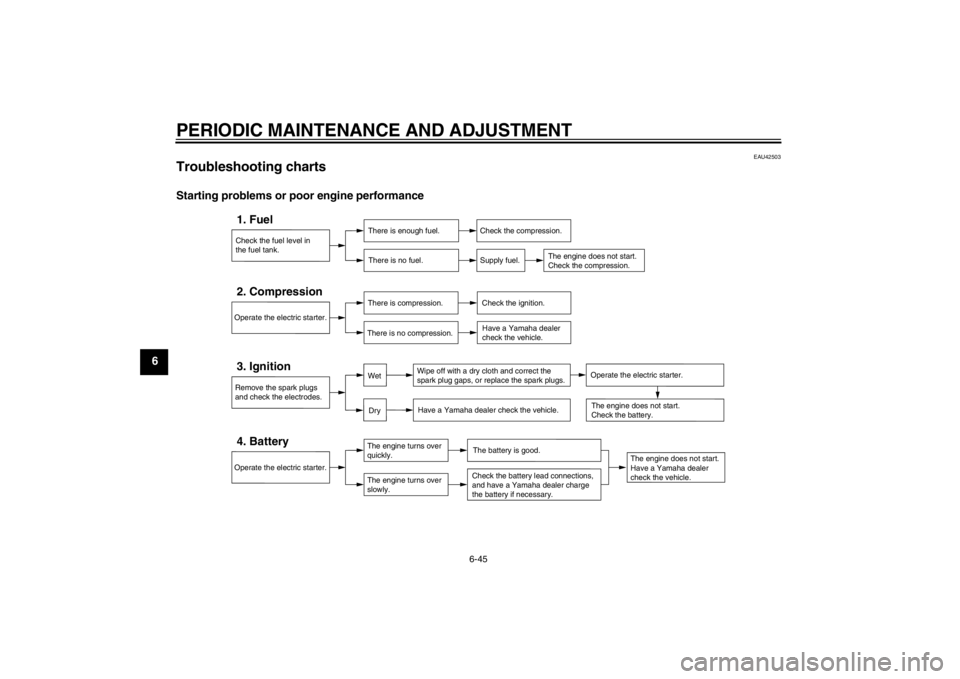
PERIODIC MAINTENANCE AND ADJUSTMENT
6-45
6
EAU42503
Troubleshooting charts Starting problems or poor engine performance
Check the fuel level in
the fuel tank.1. Fuel
There is enough fuel.There is no fuel.
Check the compression.
Supply fuel.
The engine does not start.
Check the compression.
Operate the electric starter.2. Compression
There is compression.
There is no compression.
Check the ignition. Have a Yamaha dealer
check the vehicle.
Remove the spark plugs
and check the electrodes.3. Ignition
Wipe off with a dry cloth and correct the
spark plug gaps, or replace the spark plugs.
Have a Yamaha dealer check the vehicle.
The engine does not start.
Have a Yamaha dealer
check the vehicle.
The engine does not start.
Check the battery.
Operate the electric starter.4. Battery
The engine turns over
quickly.
The engine turns over
slowly.
The battery is good.Check the battery lead connections,
and have a Yamaha dealer charge
the battery if necessary.
DryWet
Operate the electric starter.
U1JSE1E0.book Page 45 Wednesday, June 6, 2012 10:05 AM
Page 101 of 110
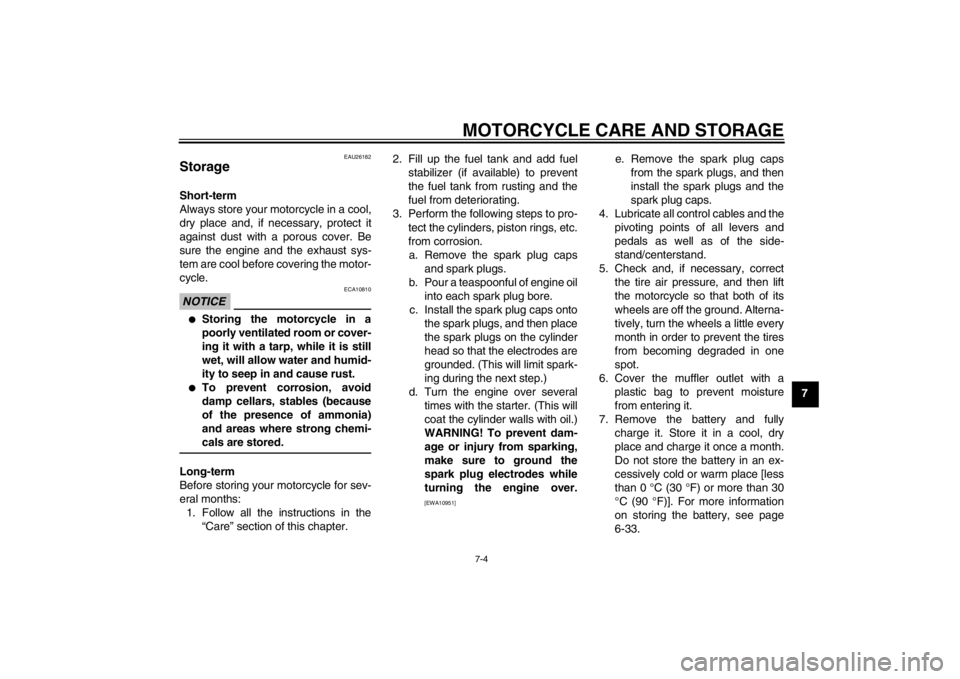
MOTORCYCLE CARE AND STORAGE
7-4
7
EAU26182
Storage Short-term
Always store your motorcycle in a cool,
dry place and, if necessary, protect it
against dust with a porous cover. Be
sure the engine and the exhaust sys-
tem are cool before covering the motor-
cycle.NOTICE
ECA10810
●
Storing the motorcycle in a
poorly ventilated room or cover-
ing it with a tarp, while it is still
wet, will allow water and humid-
ity to seep in and cause rust.
●
To prevent corrosion, avoid
damp cellars, stables (because
of the presence of ammonia)
and areas where strong chemi-
cals are stored.
Long-term
Before storing your motorcycle for sev-
eral months:1. Follow all the instructions in the “Care” section of this chapter. 2. Fill up the fuel tank and add fuel
stabilizer (if available) to prevent
the fuel tank from rusting and the
fuel from deteriorating.
3. Perform the following steps to pro- tect the cylinders, piston rings, etc.
from corrosion.a. Remove the spark plug caps and spark plugs.
b. Pour a teaspoonful of engine oil into each spark plug bore.
c. Install the spark plug caps onto the spark plugs, and then place
the spark plugs on the cylinder
head so that the electrodes are
grounded. (This will limit spark-
ing during the next step.)
d. Turn the engine over several times with the starter. (This will
coat the cylinder walls with oil.)
WARNING! To prevent dam- age or injury from sparking,
make sure to ground the
spark plug electrodes while
turning the engine over.
[EWA10951]
e. Remove the spark plug caps from the spark plugs, and then
install the spark plugs and the
spark plug caps.
4. Lubricate all control cables and the pivoting points of all levers and
pedals as well as of the side-
stand/centerstand.
5. Check and, if necessary, correct the tire air pressure, and then lift
the motorcycle so that both of its
wheels are off the ground. Alterna-
tively, turn the wheels a little every
month in order to prevent the tires
from becoming degraded in one
spot.
6. Cover the muffler outlet with a plastic bag to prevent moisture
from entering it.
7. Remove the battery and fully charge it. Store it in a cool, dry
place and charge it once a month.
Do not store the battery in an ex-
cessively cold or warm place [less
than 0 °C (30 °F) or more than 30
°C (90 °F)]. For more information
on storing the battery, see page
6-33.
U1JSE1E0.book Page 4 Wednesday, June 6, 2012 10:05 AM
Page 105 of 110

SPECIFICATIONS
8-3
8
Charging system:AC magnetoBattery:Model:
YTZ10S
Voltage, capacity: 12 V, 8.6 AhHeadlight:Bulb type:
Halogen bulbBulb voltage, wattage × quantity:Headlight:
12 V, 55.0 W × 2
Tail/brake light:
LED
Front turn signal light: 12 V, 10.0 W × 2
Rear turn signal light: 12 V, 10.0 W × 2
Auxiliary light:
LED
License plate light: 12 V, 5.0 W × 1
Meter lighting: LED
Neutral indicator light:
LED
High beam indicator light: LED
Oil level warning light: LED
Turn signal indicator light:
LED Fuel level warning light:
LED
Coolant temperature warning light: LED
Engine trouble warning light:
LED
Immobilizer system indicator light: LED
Shift timing indicator light: LED
Fuses:Main fuse:50.0 A
Headlight fuse: 15.0 A
Taillight fuse:
7.5 A
Signaling system fuse: 10.0 A
Ignition fuse: 15.0 A
Radiator fan fuse:
15.0 A × 2
Fuel injection system fuse: 15.0 A
Backup fuse: 7.5 A
Electronic throttle valve fuse:
7.5 A
U1JSE1E0.book Page 3 Wednesday, June 6, 2012 10:05 AM
Page 107 of 110

INDEX
AAir filter element.................................... 6-19
Auxiliary light ........................................ 6-39BBattery .................................................. 6-33
Brake and clutch levers, checking and lubricating ..................... 6-31
Brake and shift pedals, checking and lubricating ..................... 6-30
Brake fluid, changing ............................ 6-27
Brake fluid level, checking .................... 6-25
Brake lever ........................................... 3-16
Brake lever free play, checking ............ 6-24
Brake light switches .............................. 6-24
Brake pedal .......................................... 3-16CCables, checking and lubricating .......... 6-29
Care ........................................................ 7-1
Catalytic converters .............................. 3-19
Clutch lever........................................... 3-15
Clutch lever free play, adjusting ........... 6-23
Coolant ................................................. 6-16
Coolant temperature warning light.......... 3-5
Cowlings and panels, removing and installing......................... 6-8DDimmer switch ...................................... 3-14
Drive chain, cleaning and lubricating .... 6-29
Drive chain slack .................................. 6-27EEngine break-in ...................................... 5-3
Engine idling speed, checking .............. 6-19
Engine oil and oil filter cartridge ........... 6-13
Engine stop switch................................ 3-14 Engine trouble warning light .................... 3-7
EXUP system ........................................ 3-27
FFront and rear brake pads, checking .... 6-25
Front fork, adjusting .............................. 3-22
Front fork, checking...............................6-32
Fuel ....................................................... 3-17
Fuel consumption, tips for reducing ........ 5-3
Fuel level warning light............................ 3-4
Fuel tank breather hose and
overflow hose ...................................... 3-19
Fuel tank cap......................................... 3-17
Fuses, replacing .................................... 6-35HHandlebar switches ............................... 3-14
Hazard switch........................................ 3-15
Headlight bulb, replacing....................... 6-36
Helmet holding cable.............................3-21
High beam indicator light......................... 3-4
Horn switch ........................................... 3-14IIdentification numbers ............................. 9-1
Ignition circuit cut-off system ................. 3-28
Immobilizer system .................................3-1
Immobilizer system indicator light ........... 3-7
Indicator lights and warning lights ........... 3-4LLicense plate light bulb, replacing ......... 6-38
Luggage strap holders .......................... 3-27MMain switch/steering lock ........................ 3-2
Maintenance and lubrication, periodic..... 6-4
Maintenance, emission control system ... 6-3
Matte color, caution .................................7-1 Model label ............................................. 9-1
Multi-function meter unit ......................... 3-8
NNeutral indicator light .............................. 3-4OOil level warning light .............................. 3-4PParking.................................................... 5-4
Part locations .......................................... 2-1
Pass switch ........................................... 3-14RRear view mirrors.................................. 3-22SSafety information ................................... 1-1
Seats..................................................... 3-20
Shifting .................................................... 5-2
Shift pedal ............................................. 3-15
Shift timing indicator light ........................ 3-7
Shock absorber assembly, adjusting .... 3-24
Sidestand .............................................. 3-28
Sidestand, checking and lubricating ..... 6-31
Spark plugs, checking........................... 6-12
Specifications.......................................... 8-1
Starting the engine.................................. 5-1
Start switch ........................................... 3-14
Steering, checking ................................ 6-33
Storage ................................................... 7-4
Supporting the motorcycle .................... 6-39
Swingarm pivots, lubricating ................. 6-32TTail/brake light ...................................... 6-37
Throttle grip and cable,
checking and lubricating ..................... 6-30
Throttle grip free play, checking............ 6-19
U1JSE1E0.book Page 1 Wednesday, June 6, 2012 10:05 AM